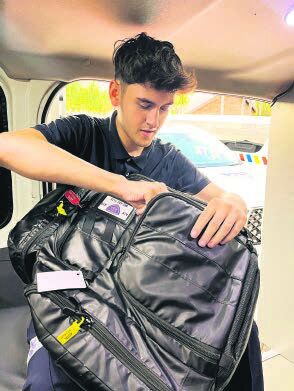A handful of volunteers from Pretoria Volunteer Emergency Services work after-hours and over weekends to assist emergency personnel and police at accident scenes.

JJ Pretorius treats a motorcycle rider while other volunteers block the traffic. Picture: Supplied
When Ettienne van Rooyen and JJ Pretorius from Pretoria knock off from their nine-to-five day jobs, they don’t go home to relax.
Instead they put on reflective gear and pack their response car with the equipment to save lives.
They are part of a handful of volunteers from Pretoria Volunteer Emergency Services who work after-hours and over weekends to assist emergency personnel and police at accident scenes around Pretoria.
Free but fulfilling
Van Rooyen has been saving lives for the past 25 years in Pretoria. He said he gets more out of saving lives after-hours for free than from the salary he receives for his day job.
“It’s amazing and I enjoy it. It’s very fulfilling. It’s about practising the skills to help or save someone’s life,” he said.
Van Rooyen, who started volunteering in 2000, is a certified intermediate life support responder who works in IT by day and on the streets by night.
“I had done first aid training in school already, so the calling has long been coming, but I never really pursued it because my father wanted me to farm. IT was already a different world to him,” he said.
Van Rooyen has completed his intermediate life support nine-month-long part-time course. But he couldn’t go any further in the field because the courses are now on a full-time basis only.
“There are so many people that need help, who don’t have medical aid and private services seldom respond. I realised people who don’t have medical aid have a big problem,” he said.
‘The good, bad, ugly and funny’

Some weekends are quiet while other nights they only clock out at around 2am and have to get up to go to work the following day.
“We have seen it all, the good, bad, ugly and funny,” he said. Van Rooyen said some people who overdose on recreational drugs do weird and funny things, especially when they mix their medication.
ALSO READ: 1985 Westdene bus disaster: A day even heroes can’t forget
He said there was no such thing as an average night. He has seen terrible scenes where people’s heads were bashed in after major accidents and other emergencies.
Van Rooyen’s sidekick, JJ Pretorius, is a technician by day and a first responder by night.
“I have seen bad things, children flung from a car and hanging in a tree. That’s why I always say, buckle up your kids.” Pretorius said different people handled grief differently.
“I struggle with it. Some cry, some scream, everyone reacts differently,” he said.
Emergency Services challenges
Pretoria Volunteer Emergency Services founder Hugo Minnaar said he wrote a post on Facebook last week which was shared more than 2.9 million times in the heat of the moment.
“I was just gatvol.” He wrote that two patients had died because the ambulances didn’t arrive.
“No government EMS services arrived, no private service arrived. Not one. Instead, we were asked: does the patient have medical aid? And were told they were too far away,” he wrote.
The Pretoria Volunteer Emergency Services comprises advanced first aiders, nurses, doctors and paramedics.
Limited resources

Minnaar said they have limited resources and the volunteers use their own vehicles, fuel and medical equipment.
“Our volunteers have also purchased defibrillators, heart monitors and oxygen out of their own pockets. Small donations have been used to buy disposable equipment like bandages, IV drips and medications,” he added.
Minnaar explained in the post that went viral that drips, defib pads, medication and fuel to get to the scene were paid for by the volunteers.
ALSO READ: Health department addresses Tshwane clinic ‘medicine shortages’
“We fund our own operations. No government support. No big donors. Just a few people with medical training, hearts that care and wallets that are running dry. We’re not asking for medals. But we are asking for support,” he said.
Minnaar said despite the post going viral it didn’t bring in much support. “The finances for medicine and the treatment for patients has become the cost of the volunteers to carry.”
EMS regulations obstacle
Bestcare Ambulance Service paramedic and director of a nonprofit emergency support team Xander Loubser described Minnaar’s post as heartbreaking and said it was clear that the EMS regulations of 2017 were a major obstacle.
“This makes it difficult for non-profit organisations to function effectively. As a private ambulance service, we do a lot of pro bono work, but we are left with many unpaid bills that end up being written off as bad debts.
“This can lead to financial difficulties that prevent us from providing quality care, or even surviving,” he said.
‘Passion for helping’

Grade 12 pupil Lawrence Lee, who is volunteering at Bestcare Ambulance Service, said he knew from a young age he wanted to become a paramedic.
“I have always had a passion for helping people, especially in times of need. What inspires me is how paramedics make a difference in the lives of others,” he said.
Download our app




